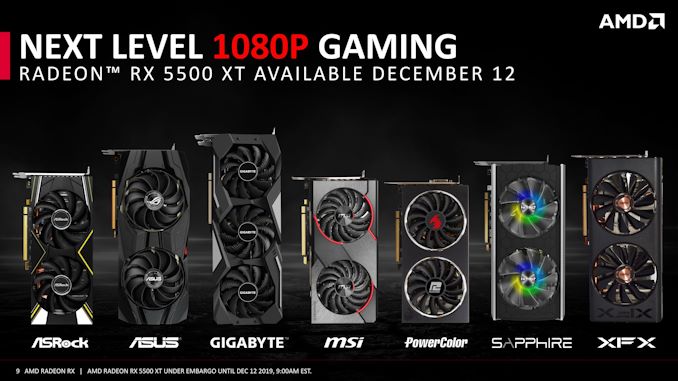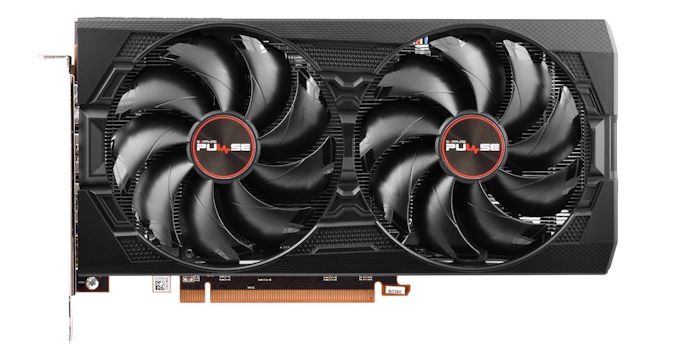The AMD Radeon RX 5500 XT Review, Feat. Sapphire Pulse: Navi For 1080p
by Ryan Smith on December 12, 2019 9:00 AM ESTClosing Thoughts
While the launch of the Radeon RX 5700 series and the underlying Navi 10 GPU was not a slam dunk for AMD’s GPU division, it was none the less an important achievement. The combination of the new RDNA core architecture as well as TSMC’s 7nm process gave AMD a significant kick in both performance efficiency and power efficiency. And in the process, it set a template for all the Radeon RX 5000 series cards to follow.
So it shouldn’t be too surprising then that the new Radeon RX 5500 XT gets to enjoy much the same situation. Compared to AMD’s previous generation Polaris-based RX 500 series cards, the 1080p-focused RX 5500 XT delivers better performance, and it does so while drawing noticeably less power. Even compared to their NVIDIA rivals, AMD is generally competitive on power efficiency in a class of cards where they were well behind in the previous generation.
Competitive performance, meanwhile, is a bit of a trickier subject. As the replacements to the RX 570/580/590 within AMD’s stack, the RX 5500 XT almost always beats AMD’s older cards, the one odd exception to this being Metro Exodus. As a result, AMD’s cheaper 4GB RX 5500 XT looks especially good here, reaching performance parity with NVIDIA’s recently launched and similarly priced GeForce GTX 1650 Super. As is usually the case, the cards are anything but equal on a game-by-game basis, constantly trading wins and losses, but at the end of the day they’re fighting over the same market with the same performance.
The 8GB RX 5500 XT, on the other hand, faces tougher competition. The extra VRAM helps to boost its performance and its price, putting it in competition with NVIDIA’s somewhat awkwardly placed GTX 1660. The GTX 1660 is an odd man out as the only current-generation GDDR5 card among the contenders, and yet it’s still fast enough to remain several percent ahead of the 8GB RX 5500 XT. To be sure, AMD’s new card puts up a great fight, coming closer to meeting NVIDIA in both performance and power efficiency than any previous AMD card; but at the end of the day it’s not enough to completely close the gap with NVIDIA’s closest competitor. Which is not to say that the RX 5500 XT is entirely outclassed here, but the GTX 1660 leads by just enough that it can’t be entirely ignored.
| Performance Summary (1080p) | ||||
| Relative Performance | Relative Price |
|||
| RX 5500 XT 4GB vs GTX 1650S | 0% | +6% | ||
| RX 5500 XT 8GB vs GTX 1660 | -8% | -5% | ||
| RX 5500 XT 8GB vs RX 580 8GB | +8% | +11% | ||
| RX 5700 vs. RX 5500 XT 8GB | +60% | +60% | ||
Throwing a wrench into all of this however – for both AMD and NVIDIA – is VRAM capacity. VRAM isn’t cheap, and GDDR6 even less so, so both vendors are using VRAM capacity as product differentiators and to upsell their better cards. But as VRAM capacity in the $150-$200 price range has been pretty stagnant for the last couple of years now, I do have some concerns about the long-term implications for the 4GB RX 5500 XT, especially with the next-generation consoles set to launch in a year’s time. With the consoles setting the baseline for most multiplatform games, it’s a reasonable bet that VRAM requirements aren’t going to stay put at 4GB much longer. So while the 4GB RX 5500 XT is a great value now, I suspect it’s going to run out of VRAM well before its compute performance gets to be a bottleneck. And while NVIDIA’s GTX 1660 fares better here with its 6GB of VRAM, 6GB is still not 8GB.
Overall then, the VRAM situation adds an extra wrinkle to any kind of product recommendations, as it’s one more variable that deserves consideration.
At the end of the day, I don’t think any 4GB cards are a great choice right now. For buyers who absolutely cannot afford to spend more than $169, then the 4GB RX 5500 XT or NVIDIA’s GeForce GTX 1650 Super counterpart are both going to be the best choices you can make right now, at least among the current-generation cards. However, spending another $30 to get a better card is going to get you a card with at least 6GB of VRAM and 6% more perforamnce, and that’s going to remain relevant for a lot longer than a 4GB card will in 2020.
Choosing between the 8GB RX 5500 XT and GTX 1660, on the other hand, is a bit harder. AMD has a 2GB VRAM advantage, which is likely to be helpful in the future; but right now they can’t match NVIDIA’s performance or feature advantage. Ultimately I’m not sure there’s a clearly correct answer here – at least, not one that can be backed entirely with hard data. In the meantime however, as the second to market it's up to AMD to make a convincing showing if they want to dislodge NVIDIA's existing GTX 1660.
As for Sapphire’s Pulse RX 5500 XT in particular, it’s hard to envision a better card to show off the Radeon RX 5500 XT. If you can look past the card’s somewhat ridiculous size for its class, the product as a whole is just about everything you could want out of a reference clocked card. The build quality is solid, the included TriXX software is handy, and the acoustics are incredible. It may not be a silent card, but with two giant fans to push plenty of air with ease, it may just as well be.
And with that, AMD is set to wrap up their GPU lineup for 2019. At only 3 Navi cards in, AMD is far from done in fleshing out a complete, top-to-bottom family of video cards. But for now, AMD is able to hit the mainstream and performance segments, which is a good place to stop for a bit and reflect as we go into the holidays.












97 Comments
View All Comments
dr.denton - Friday, December 13, 2019 - link
Bought an RX570 8GB this summer and feeling pretty good about that decision right now. Especially seeing how well Polaris cards seem to hold up in modern titles like Metro and RDR2.n0x1ous - Thursday, December 12, 2019 - link
Only matching power numbers with 7nm vs Nvidia's 12nm. Sad. Nvidia on 7nm is going to dominate again.Fataliity - Thursday, December 12, 2019 - link
Nvidia's 7nm should be going against RDNA2. Which I"m sure will help alot. RDNA was rebuilt because of issues, and didn't get everything it was supposed to (Similar to Zen vs Zen2. They could only do so much with its budget).This is their first gen of a new arch.
Personally though, the compression synthetics speak the biggest to me. They need to match Nvidia's compression on color changes for bandwidth. That's why AMD's cards need more TFLOPS to reach same performance. If they can get their compression to Nvidia's level, then I think it will do wonders for their numbers.
eva02langley - Thursday, December 12, 2019 - link
However during that time, AMD image quality is better.peevee - Friday, December 20, 2019 - link
Their cards have so much memory bandwidth compared to flops they would not benefit much from compression I 'm afraid.Something else is terribly wrong. Just not enough ALUs on 5500 series, have to keep frequency up = bad efficiency. They needed to use TSMCs high-density/low-power libraries, not high-performance libraries for GPUs... They would be immensely better with twice as many ALUs at 1GHz and low-power DDR5...
eva02langley - Thursday, December 12, 2019 - link
It is the first iteration of a new uarch, things will only get better and better.jabber - Thursday, December 12, 2019 - link
Oh well no need to swap out my 480 for another year at least.eva02langley - Thursday, December 12, 2019 - link
Hell no, you don't need to. This generation of cards is the first time I can remember seeing identical performances for the same price tag.lightningz71 - Thursday, December 12, 2019 - link
So, for what I'm seeing, if you're shopping for a sub-$200 video card, you have the following scenario:1) If you have no real concerns about power usage (i.e. have a 750+ watt PSU and don't have high electricity costs) then the RX590-8GB Cards offer you the best bang for the buck.
2)If power is a MAJOR issue for you, the GeForce 1650 Super is your best option, unless you absolutely need to have more VRAM, then it's the 5500XT 8GB.
3) If you need solid drivers and advanced video encoding/decoding codec support, the 1660 is what you need as it has the full, current NVenc solution that appears to outstrip AMD for the moment.
For me, with an 850 Watt PSU, and only an occasional gamer and desktop user, I'm going to be looking at good deals on the RX590 8GB for now, unless the 1660 super comes down drastically in price.
eva02langley - Thursday, December 12, 2019 - link
Total disinformation, you don't need a 750W Power Supply for a 590. 500W is more than enough. Basically, If you don't have a 9900k or an OC R9 3000, I don't see the need for more than 500-600 Watts.